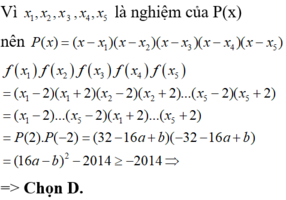P(x) = x5 – 2 + x + x3 + x2 ; Q(x) = – 1 + 4x5 + x4 + x2 + x3
Sắp xếp các hạng tử mỗi đa thức theo lũy thừa tăng dần của biến.
Tính P(x) + Q(x) và P(x) – Q(x).

Những câu hỏi liên quan
Cau 1:
Tim x, biet: 1-4+7-10+.............-x=-75
Cau 2:
Cho x1, x2, x3, x4, x5 thuộc Z
Biết x1+ x2 + x3 + x4 + x5=0
và x1 + x2=x3+ x4= x4 + x5 =2
Tinh x3, x4 , x5
Cau 3: Tim x biet
(x+7+1) chia het cho (x+7)
Giả sử đa thức
P
(
x
)
x
5
-
a
x
4
+
b
có năm nghiệm
x
1
;
x
2
;
x
3
;
x
4
;
x
5
Đặt
f
(
x
)...
Đọc tiếp
Giả sử đa thức P ( x ) = x 5 - a x 4 + b có năm nghiệm x 1 ; x 2 ; x 3 ; x 4 ; x 5 Đặt f ( x ) = x 2 - 4 Tìm giá trị nhỏ nhất của P = f ( x 1 ) f ( x 2 ) f ( x 3 ) f ( x 4 ) f ( x 5 )
A. 512
B. -512
C. 1024
D. -1024
Cho 2 đa thức j (x) = x5 - x3 - x2 - 2x +5 và g (x) = x2 - 3x + 1 + x2 - x4 + x5.
Hãy tính tổng j (x) + g (x)
\(Tacó:f\left(x\right)+g\left(x\right)=x^5-x^3+x^2-2x+5+x^2-3x+1+x^2-x^4+x^5\)
Đúng 0
Bình luận (0)
Ta có : j(x) + g(x) = (x5 - x3 - x2 - 2x +5 )+( x2 - 3x + 1 + x2 - x4 + x5)
= x5 - x3 - x2 - 2x +5+x2 - 3x + 1 + x2 - x4 + x5
=(x5 + x5) + (-3x - 3x) + (-2x+2x-2x)+ (5 +1) -4x
= 10x - 6x - 2x +6 - 4x
= -2x +6
Vậy j(x) + g(x) = -2x +6
Đúng 0
Bình luận (4)
\(j\left(x\right)+g\left(x\right)=2x^5-x^4-x^3+x^2-5x+6\)
#Walker
Đúng 0
Bình luận (0)
Xem thêm câu trả lời
Bài 1 : Cho a,b,c là các số hữu tỉ khác 0 sao cho a+b-c/c=a-b+c/b=(-a)+b+c/a
Tính giá trị của biểu thức A=(a+b).(b+c).(c+a)/abc
(LƯU Ý : DẤU / LÀ ...TRÊN.....)
Bài 2 : Cho x,x2,x3,x4,x5,x6 thỏa mãn :
(x2)^2=x1.x3
(x3)^2=x2.x4
(x4)^2=x3.x5
(x5)^2=x4.x6
Chứng minh rằng : x1/x6=(x1+x2+x3+x4+x5/x2+x3+x4+x5+x6)^5
Giusp mk vs nhé các bn !!!
Tính f(x) + g(x) với:
f(x) = x5 – 3x2 + x3 – x2 – 2x + 5
g(x) = x2 – 3x + 1 + x2 – x4 + x5
Thu gọn, sắp xếp đa thức theo lũy thừa giảm của biến:
* Ta có: f(x) = x5 – 3x2 + x3 – x2 – 2x + 5
= x5 – (3x2 + x2 ) + x3 - 2x + 5
= x5 – 4x2 + x3 – 2x + 5
= x5 + x3 – 4x2 – 2x + 5
Và g(x) = x2 – 3x + 1 + x2 – x4 + x5
= (x2 + x2 ) – 3x + 1 – x4 + x5
= 2x2 – 3x + 1 – x4 + x5
= x5 – x4 + 2x2 – 3x + 1
* f(x) + g(x):

Đúng 0
Bình luận (0)
Cho đa thức
F(x)=x5 - 3x2 -x3 - x2 - 2x + 5
G(x)+x5 - x4 + x2 - 3x + x2 + 1
Tính H(x) = F(x) + G(x)
\(H\left(x\right)=F\left(x\right)+G\left(x\right)=\left(x^5-3x^2-x^3-x^2-2x+5\right)+\left(x^5-x^4+x^2-3x+x^2+1\right)\\ =x^5-3x^2-x^3-x^2-2x+5+x^5-x^4+x^2-3x+x^2+1\\ =\left(x^5+x^5\right)-x^4-x^3-\left(3x^2+x^2-x^2-x^2\right)-\left(2x+3x\right)+5\\ =2x^5-x^4-x^3-2x^2-5x+5\)
Đúng 0
Bình luận (0)
Tính f(x) - g(x) với:
f(x) = x5 – 3x2 + x3 – x2 – 2x + 5
g(x) = x2 – 3x + 1 + x2 – x4 + x5
giúp với ạ
\(f\left(x\right)-g\left(x\right)=\left(x^5-3x^2+x^3-x^2-2x+5\right)-\left(x^2-3x+1+x^2-x^4+x^5\right)\)
\(f\left(x\right)-g\left(x\right)=x^5-3x^2+x^3-x^2-2x+5-x^2+3x-1-x^2+x^4-x^5\)
\(f\left(x\right)-g\left(x\right)=\left(x^5-x^5\right)+\left(-3x^2-x^2-x^2-x^2\right)+x^3+\left(-2x+3x\right)+\left(5-1\right)+x^4\)
\(f\left(x\right)-g\left(x\right)=-6x^2+x^3+x+4+x^4\)
\(f\left(x\right)-g\left(x\right)=x^4+x^3-6x^2+x+4\)
Đúng 0
Bình luận (4)
Cho hai đa thức P(x)= x5-5x3+4x+1, Q(x)=2x2+x-1. Gọi x1,x2,x3,x4,x5 là các ng của P(x)
Tính Q(x1).Q(x2).Q(x3).Q(x4).Q(x5)
Vì P(x) có hệ số bậc cao nhất là 1
Nên P(x) có thể được viết dưới dạng: \(P\left(x\right)=\left(x-x_1\right)\left(x-x_2\right)\left(x-x_3\right)\left(x-x_4\right)\left(x-x_5\right)\)
Và \(P\left(-1\right)=\left(-1\right)^5-5\left(-1\right)^3+4\left(-1\right)+1=1\)
\(P\left(\frac{1}{2}\right)=\frac{77}{32}\)
Ta có: \(Q\left(x\right)=2x^2+x-1=2x^2+2x-x-1=2x\left(x+1\right)-\left(x+1\right)=\left(x+1\right)\left(2x-1\right)\)
=> \(Q\left(x_1\right).\text{}\text{}Q\left(x_2\right).\text{}\text{}Q\left(x_3\right).\text{}\text{}Q\left(x_4\right).\text{}\text{}Q\left(x_5\right)\text{}\text{}\)
\(=\left(x_1+1\right)\left(2x_1-1\right)\left(x_2+1\right)\left(2x_2-1\right)\left(x_3+1\right)\left(2x_3-1\right)\left(x_4+1\right)\left(2x_4-1\right)\left(x_5+1\right)\left(2x_5-1\right)\)
\(=32\left(-1-x_1\right)\left(\frac{1}{2}-x_1\right)\left(-1-x_2\right)\left(\frac{1}{2}-x_2\right)\left(-1-x_3\right)\left(\frac{1}{2}-x_3\right)\left(-1-x_4\right)\left(\frac{1}{2}-x_4\right)\left(-1-x_5\right)\left(\frac{1}{2}-x_5\right)\)\(=32.P\left(-1\right).P\left(\frac{1}{2}\right)=32.1.\frac{77}{32}=77\)
\(p\left(x\right)=x^5-5x^3+4x+1=\left(x-x_1\right)\left(x-x_2\right)\left(x-x_3\right)\left(x-x_4\right)\left(x-x_5\right)\)
\(Q\left(x\right)=2\left(\frac{1}{2}-x\right)\left(-1-x\right)\)
Do đó \(Q\left(x_1\right)\cdot Q\left(x_2\right)\cdot Q\left(x_3\right)\cdot Q\left(x_4\right)\cdot Q\left(x_5\right)\)
\(=2^5\left[\left(\frac{1}{2}-x_1\right)\left(\frac{1}{2}-x_2\right)\left(\frac{1}{2}-x_3\right)\left(\frac{1}{2}-x_4\right)\left(\frac{1}{2}-x_5\right)\right]\)
\(=\left(-1-x_1\right)\left(-1-x_2\right)\left(-1-x_3\right)\left(-1-x_4\right)\left(-1-x_5\right)\)
\(=32P\left(\frac{1}{2}\right)\cdot\left[P\left(-1\right)\right]\)
\(=32\cdot\left(\frac{1}{32}-\frac{5}{8}+\frac{4}{2}+1\right)\left(-1+5-4+1\right)\)
\(=4300\)
*Mình không chắc*
Cho hai đa thức
P
(
x
)
2
x
3
-
3
x
+
x
5
-
4
x
3
+
4
x
-
x
5
+
x
2
-
2
;
Q
(
x
)...
Đọc tiếp
Cho hai đa thức
P ( x ) = 2 x 3 - 3 x + x 5 - 4 x 3 + 4 x - x 5 + x 2 - 2 ; Q ( x ) = x 3 - 2 x 2 + 3 x + 1 + 2 x 2
Tính P(x) - Q(x)
A. - 3 x 3 + x 2 - 2 x + 1
B. - 3 x 3 + x 2 - 2 x - 3
C. 3 x 3 + x 2 - 2 x - 3
D. - x 3 + x 2 - 2 x - 3
Ta có
P ( x ) = 2 x 3 − 3 x + x 5 − 4 x 3 + 4 x − x 5 + x 2 − 2 = x 5 − x 5 + 2 x 3 − 4 x 3 + x 2 + ( 4 x − 3 x ) − 2 = − 2 x 3 + x 2 + x − 2 Và Q ( x ) = x 3 − 2 x 2 + 3 x + 1 + 2 x 2
= x 3 + - 2 x 2 + 2 x 2 + 3 x + 1 = x 3 + 3 x + 1
Khi đó
P ( x ) − Q ( x ) = − 2 x 3 + x 2 + x − 2 − x 3 + 3 x + 1 = − 2 x 3 + x 2 + x − 2 − x 3 − 3 x − 1 = − 2 x 3 − x 3 + x 2 + ( x − 3 x ) − 2 − 1 = − 3 x 3 + x 2 − 2 x − 3
Chọn đáp án B
Đúng 0
Bình luận (0)
Cho
f
(
x
)
x
2
+
2
x
3
-
7
x
5
-
9
-
6
x
7
+
x
3
+
x
2
+
x
5
-
4
x
2
+...
Đọc tiếp
Cho
f ( x ) = x 2 + 2 x 3 - 7 x 5 - 9 - 6 x 7 + x 3 + x 2 + x 5 - 4 x 2 + 3 x 7 g ( x ) = x 5 + 2 x 3 - 5 x 8 - x 7 + x 3 + 4 x 2 - 5 x 7 + x 4 - 4 x 2 - x 6 - 12 h ( x ) = x + 4 x 5 - 5 x 6 - x 7 + 4 x 3 + x 2 - 2 x 7 + x 6 - 4 x 2 - 7 x 7 + x
Tính f(x) + g(x) – h(x)
























